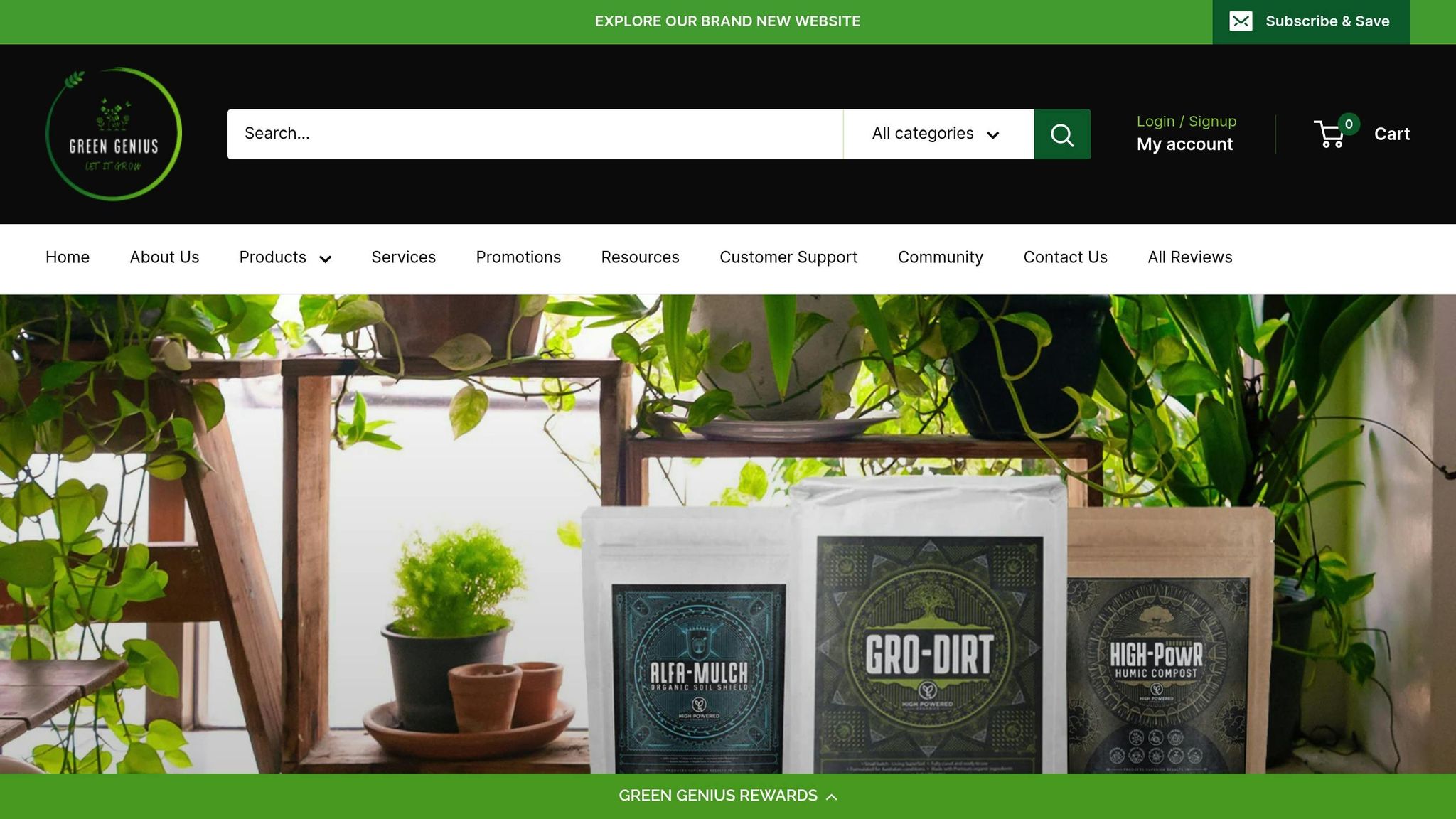Living soil is a living ecosystem that supports plant health through microbes, organic matter, and nutrient cycling. If your plants show yellowing leaves, poor growth, or struggle with pests, your soil might need re-amending. Here's how to restore balance:
- Test Your Soil: Use a test like Meilich III to check nutrients, pH, and organic matter.
- Add Organic Materials: Mix compost, worm castings, and mulch to boost nutrients and microbial activity.
- Introduce Beneficial Microbes: Add inoculants with fungi and bacteria to help plants thrive.
- Adjust with Amendments: Use lime, rock dust, or kelp meal based on specific deficiencies.
Maintain soil health with regular testing, crop rotation, and consistent organic matter additions. Keep pH between 5.8–6.5 and aim for a CEC of 25–35 for optimal results.
Two Ways to Re-Amend Your Soil
How Living Soil Works
Living soil functions as a vibrant ecosystem driven by nutrient cycling. By grasping these processes, you can make better decisions about soil amendments. Let’s dive into the key microbes and the factors that keep this ecosystem thriving.
Microbes and Soil Life
At the core of living soil are its microscopic inhabitants. Bacteria, fungi, and other microorganisms play a crucial role in transforming organic matter into nutrients plants can use. These tiny organisms are responsible for:
- Breaking down organic material
- Turning nutrients into forms plants can absorb
- Improving soil structure through their activity
- Protecting plants from pests and diseases
Mycorrhizal fungi, in particular, help plants by extending their roots, allowing them to access more water and nutrients.
Main Soil Health Factors
Microbial activity is just one piece of the puzzle. Several other components are essential for maintaining soil health. Here are three critical factors:
| Factor | Role | Optimal Conditions |
|---|---|---|
| Organic Matter | Feeds microbes and boosts soil structure | Add organic materials regularly to maintain levels |
| Microbial Diversity | Promotes nutrient cycling and plant protection | Encourage a mix of beneficial microbes |
| Nutrient Balance | Supports healthy plant growth | Keep pH between 5.8–6.5 and nutrients balanced |
These factors work together to form the soil food web, a self-sustaining system when properly managed. Adding one cubic foot of high-quality compost per yard can fuel microbial activity and organic matter levels.
Soil pH is critical: acidic soils (pH <5.8) can block nutrient availability, while alkaline soils (pH >6.5) can limit access to micronutrients. Regular soil testing helps you monitor these levels and adjust amendments as needed.
Another key metric is CEC (Cation Exchange Capacity), which measures how well soil retains and releases nutrients. A CEC of 25–35 is ideal for living soil. You can boost this capacity by adding compost or earthworm castings to increase organic matter.
Understanding these aspects of soil biology sets the stage for the re-amending steps covered in the next section.
4 Steps to Re-Amend Soil
Improving your soil's health starts with understanding its biology. Follow these steps to restore balance and keep your garden thriving. Regular care ensures your soil stays alive and productive.
Step 1: Test Your Soil
Begin with a Meilich III soil test from Logan Labs to assess your soil's condition. This test provides details on nutrient levels (NPK), pH, organic matter, and cation exchange capacity (CEC). Take samples from different spots in your garden, mix them well, and send them in for analysis. The results will help you decide on the next steps for improving your soil.
Step 2: Add Organic Materials
Use the test results to guide the addition of organic materials. The right mix can breathe new life into your soil. Here's a quick guide:
| Material | Amount per Cubic Yard | Purpose |
|---|---|---|
| Quality Compost | 1–2 cubic feet | Provides nutrients and supports microbes |
| Earthworm Castings | 0.5 cubic feet | Enhances enzymes and hormones |
| Aged Mulch | 2-inch top layer | Keeps moisture and releases nutrients slowly |
Blend these materials into the top 6–8 inches of soil while it’s slightly damp for the best results.
Step 3: Introduce Beneficial Microbes
Once organic materials are added, encourage microbial activity by using inoculants rich in mycorrhizal fungi and beneficial bacteria. Allow the soil to rest for 2–4 weeks before planting. This gives the microbes time to settle in and start breaking down the organic matter.
Step 4: Choose the Right Amendments
Address specific soil issues with targeted amendments. Here's how to tackle common problems:
| Soil Issue | Amendment | Application Rate |
|---|---|---|
| Low pH (<5.8) | Agricultural lime | 5–10 lbs per 100 sq ft |
| High pH (>6.5) | Iron sulfate | 2–4 lbs per 100 sq ft |
| Trace mineral deficiency | Rock dust | 2–5 lbs per 100 sq ft |
| Low nitrogen | Kelp meal | 1–2% of soil volume |
sbb-itb-28a8941
Long-Term Soil Care
Soil Re-Use Guidelines
Reusing living soil can save both money and resources when done correctly. Start by removing old root systems and any large debris. Then, retest the soil using your preferred analysis method to check for nutrient gaps or pH imbalances.
To rejuvenate each cubic yard of reused soil, mix in 1 cubic foot of compost or worm castings. If your soil tests show mineral deficiencies, add supplements like rock dust or kelp meal, following the recommended amounts from your analysis.
Regular Soil Maintenance
Once the soil has been refreshed, regular upkeep is key to keeping it in top condition. Healthy living soil thrives with consistent monitoring and gradual nutrient replenishment. Keep the soil moist but ensure it drains well. Aim for a cation exchange capacity (CEC) between 25 and 35 to help the soil hold nutrients effectively.
Rotate crops to avoid depleting nutrients - plant soil-enriching crops like legumes after heavy feeders such as tomatoes. Keep an eye on the pH, maintaining it between 5.8 and 6.5 for most plants.
Here’s a suggested maintenance schedule:
- Monthly: Perform pH tests.
- Quarterly: Conduct a detailed soil analysis.
- Post-Harvest: Add organic amendments.
- Biannually: Perform deep soil testing.
When necessary, loosen compacted soil to maintain microbial activity and add a layer of compost between plantings to keep organic matter levels steady. This approach ensures your soil stays healthy and productive over time.
Recommended Tools and Products
Green Genius Products and Services

Green Genius specializes in soil improvement products tailored for Australian gardeners. They offer living soil amendments made with premium organic materials and microbial inoculants. Their consultation services help you create soil strategies specific to your needs. The Custom Soil Builder Kit provides pre-measured amendments based on your soil test results, and their wholesale program is designed for cost-conscious gardeners. To get the best results, pair these products with reliable soil testing.
Basic Soil Testing Equipment
Soil testing is the backbone of effective soil care. For a detailed nutrient analysis, the Meilich III test from Logan Labs costs $30–45 per sample and helps fine-tune your soil amendment plan. A digital pH meter, priced between $50–80, offers quick and dependable pH and moisture readings.
Here’s a breakdown of essential tools for home gardeners:
| Equipment Type | Price Range | Testing Frequency | Benefits |
|---|---|---|---|
| Digital pH Meter | $50–80 | Weekly | Quick pH and moisture readings |
| Complete Soil Test Kit | $30–45 | Quarterly | Full nutrient and CEC analysis |
| Compost Thermometer | $20–35 | During composting | Tracks composting progress |
| EC Meter | $40–60 | Monthly | Monitors nutrient salt levels |
For composting and soil mixing, durable tools are a must. A compost turner ($150–200) ensures proper aeration, speeding up decomposition, while a manual soil sieve ($40–60) helps remove debris for smooth, uniform mixes.
When choosing testing equipment, focus on accuracy rather than extra features. Simple models often deliver better results than overly complex ones. To keep your equipment in top shape, store it in a cool, dry location and calibrate your pH meter monthly.
Main Points Review
Regular soil testing provides essential insights into nutrient levels and pH balance. Incorporating organic materials like compost and earthworm castings not only replenishes nutrients but also boosts microbial activity. These actions help restore balance and promote healthier gardening practices.
By focusing on these steps, you can take meaningful actions to improve your soil.
Next Steps
Begin with a soil test to understand its current condition. Consider using trusted services like Logan Labs for nutrient analysis to guide your amendment decisions. Select specific organic amendments and make gradual improvements for sustainable results.
Stick to a regular testing routine to monitor and maintain soil health over time. Consistency is key to achieving and preserving long-term soil vitality.

